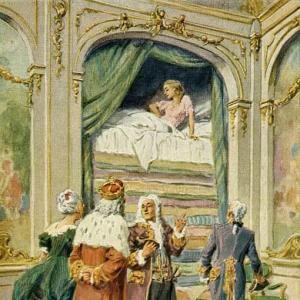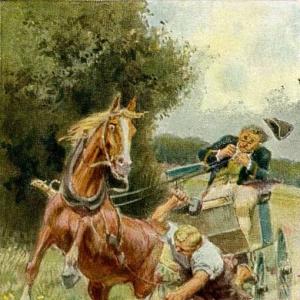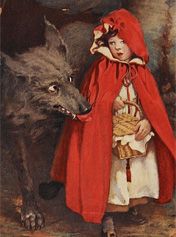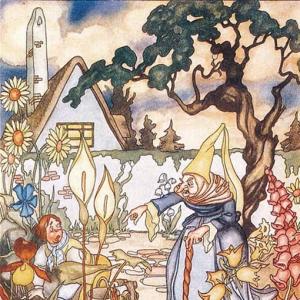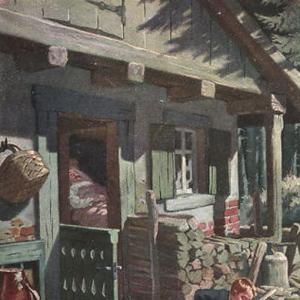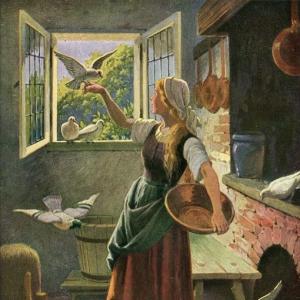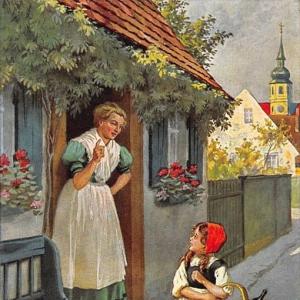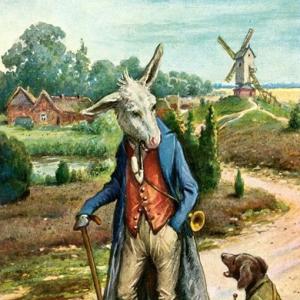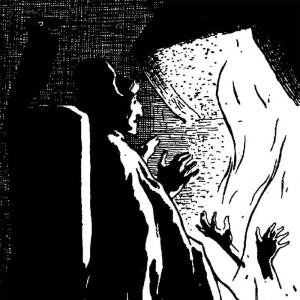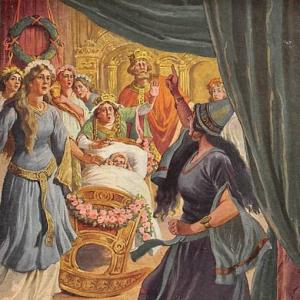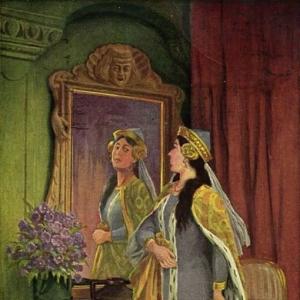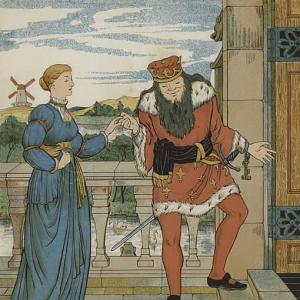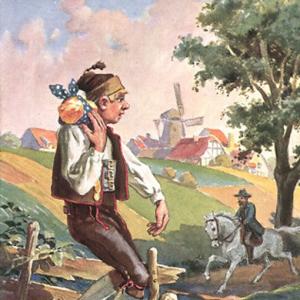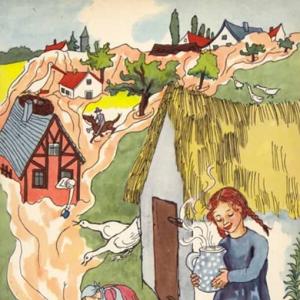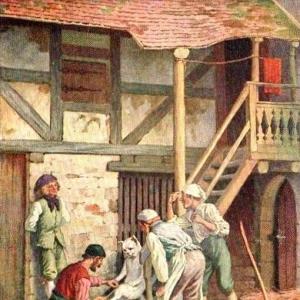Reading time for children: 5 min
Attention: This is a scary and antisemitic story.
A tailor’s apprentice was travelling about the world in search of work, and at one time he could find none, and his poverty was so great that he had not a farthing to live on. Presently he met a Jew on the road, and as he thought he would have a great deal of money about him, the tailor thrust God out of his heart, fell on the Jew, and said, „Give me thy money, or I will strike thee dead.“
Then said the Jew, „Grant me my life, I have no money but eight farthings.“ But the tailor said, „Money thou hast; and it shall be produced,“ and used violence and beat him until he was near death. And when the Jew was dying, the last words he said were, „The bright sun will bring it to light,“ and thereupon he died. The tailor’s apprentice felt in his pockets and sought for money, but he found nothing but eight farthings, as the Jew had said.
Then he took him up and carried him behind a clump of trees, and went onwards to seek work. After he had traveled about a long while, he got work in a town with a master who had a pretty daughter, with whom he fell in love, and he married her, and lived in good and happy wedlock. After a long time when he and his wife had two children, the wife’s father and mother died, and the young people kept house alone.
One morning, when the husband was sitting on the table before the window, his wife brought him his coffee, and when he had poured it out into the saucer, and was just going to drink, the sun shone on it and the reflection gleamed hither and thither on the wall above, and made circles on it. Then the tailor looked up and said, „Yes, it would like very much to bring it to light, and cannot!“ The woman said, „Oh, dear husband, and what is that, then?“
What dost thou mean by that?“ He answered, „I must not tell thee.“ But she said, „If thou lovest me, thou must tell me,“ and used her most affectionate words, and said that no one should ever know it, and left him no rest. Then he told her how years ago, when he was travelling about seeking work and quite worn out and penniless, he had killed a Jew, and that in the last agonies of death, the Jew had spoken the words, „The bright sun will bring it to light.“
And now, the sun had just wanted to bring it to light, and had gleamed and made circles on the wall, but had not been able to do it. After this, he again charged her particularly never to tell this, or he would lose his life, and she did promise. When however, he had sat down to work again, she went to her great friend and confided the story to her, but she was never to repeat it to any human being, but before two days were over, the whole town knew it, and the tailor was brought to trial, and condemned. And thus, after all, the bright sun did bring it to light.
 Learn languages. Double-tap on a word.Learn languages in context with Childstories.org and Deepl.com.
Learn languages. Double-tap on a word.Learn languages in context with Childstories.org and Deepl.com.Backgrounds to fairy tale „The bright sun brings it to light“
„The Bright Sun Brings It to Light“ is a lesser-known fairy tale from the Brothers Grimm collection. As with many of the tales from the Brothers Grimm, the story is rooted in the German folklore and oral tradition. The tale addresses themes of guilt, confession, and the consequences of one’s actions. It also highlights the idea that the truth will eventually come out, no matter how long it takes or how well hidden it may be.
The origins of the story can be traced back to the European oral tradition. It is possible that the tale has been influenced by local stories and beliefs, as well as by broader European themes. The Brothers Grimm, Jacob and Wilhelm, were interested in preserving German cultural heritage, and they collected these stories in the early 19th century. They sought to record the folktales and legends that were passed down orally among the people, to ensure that these stories would not be lost to future generations.
In terms of the background and setting of the story, it appears to take place in a rural, pre-industrial Germany. The characters and social structure are representative of the time and place, with a tailor’s apprentice as the protagonist, and a Jewish character playing the role of the victim. The portrayal of the Jew in this story is reflective of the anti-Semitic attitudes that were prevalent in Europe during the time of the Brothers Grimm. This has led to criticism of the tale’s content and its representation of Jewish characters.
The Brothers Grimm began collecting fairy tales and folklore in the early 19th century, and their first volume of stories, titled „Kinder- und Hausmärchen“ (Children’s and Household Tales), was published in 1812. The collection was revised and expanded over the years, and it eventually included over 200 stories. The tales collected by the Brothers Grimm vary widely in tone and subject matter, ranging from charming and whimsical stories like „Cinderella“ and „Snow White“ to darker and more sinister tales like „The Bright Sun Brings it to Light.“ The stories often reflect the values, beliefs, and attitudes of the society in which they were collected.
It’s important to note that „The Bright Sun Brings it to Light“ contains explicit antisemitic content, reflecting the prejudices of the time in which it was written. This tale, along with some other stories in the Grimm collection, demonstrates the darker aspects of the historical context in which the brothers collected their stories. Today, readers should approach these problematic tales critically, acknowledging their historical context while recognizing their harmful nature. Overall, „The Bright Sun Brings It to Light“ is a cautionary tale about the consequences of one’s actions and the power of the truth. The story’s roots in German folklore and oral tradition give it a historical and cultural context, though its representation of certain characters and themes may be seen as problematic in modern times.
Interpretations to fairy tale „The bright sun brings it to light“
„The Bright Sun Brings it to Light“ is a lesser-known fairy tale collected by the Brothers Grimm, Jacob (1785-1863) and Wilhelm (1786-1859) Grimm, who were German academics, philologists, and folklorists. They are best known for their collection of fairy tales, which they collected as part of their efforts to preserve and document German cultural heritage. „The Bright Sun Brings It to Light“ is a complex and thought-provoking fairy tale with multiple possible interpretations. Here are some key themes and interpretations that can be drawn from the story:
The inevitability of truth: The central theme of the story is that the truth cannot be hidden forever. No matter how well the protagonist tries to conceal his crime, it eventually comes to light. The saying „the bright sun brings it to light“ serves as a metaphor for the idea that the truth has a way of revealing itself in time.
Guilt and conscience: The protagonist’s crime weighs heavily on his conscience, causing him to become paranoid and ultimately confess his actions to his wife. This theme suggests that one cannot escape the guilt of their misdeeds, and that the burden of guilt can lead to one’s downfall.
The power of gossip and confession: In the story, the protagonist’s wife plays a crucial role in spreading the truth about her husband’s crime. Her gossiping about his confession leads to his arrest and execution. This highlights the power of gossip and the importance of keeping secrets, as well as the consequences of revealing them.
Karma and retribution: The protagonist’s eventual punishment can be interpreted as a form of karmic retribution for his actions. Despite initially avoiding any consequences for his crime, the truth catches up with him in the end, and he faces the appropriate consequences for his actions. The tale may be seen as a cautionary story about the consequences of one’s actions. The apprentice’s brutal crime eventually catches up with him, despite his efforts to conceal it. The sun, symbolizing truth and justice, exposes his dark past, leading to his downfall.
The role of chance and coincidence: The story also highlights the role of chance and coincidence in the revelation of the truth. The protagonist’s careless remark about the sun bringing the truth to light serves as the catalyst for his wife’s curiosity and eventual gossiping. This can be seen as a commentary on the unpredictable nature of life and the role of fate in determining the course of events.
The Power of Secrets: The story highlights the consequences of sharing secrets and the impact of trust within relationships. The apprentice’s wife, despite her promise to keep the secret, cannot resist sharing it with her friend. This breach of trust ultimately leads to the apprentice’s punishment and underscores the importance of loyalty and discretion in relationships.
Prejudice and Stereotyping: The antisemitic undertones of the story reflect the prejudices of the time in which it was written. The apprentice’s assumptions about the Jewish man’s wealth lead to violence and tragedy. The tale can be seen as a reminder of the dangers of perpetuating stereotypes and the importance of treating individuals with respect, regardless of their background.
Inescapable Fate: The dying man’s prophecy, „The bright sun will bring it to light,“ can be interpreted as the inevitability of fate. Despite the apprentice’s efforts to escape his past, the prophecy comes true, suggesting that certain events are predestined and cannot be avoided.
Anti-Semitism and social critique: The portrayal of the Jewish character in the story can be seen as a reflection of the anti-Semitic attitudes prevalent in Europe during the time of the Brothers Grimm. This aspect of the story has been criticized for perpetuating harmful stereotypes, but it can also be interpreted as a critique of the social attitudes of the time. The Brothers Grimm, Jacob and Wilhelm Grimm, are known for their collection of fairy tales, titled „Children’s and Household Tales,“ which were published in the early 19th century. These stories have influenced Western culture significantly. However, as products of their time, the stories often include themes and content that reflect social prejudices and stereotypes prevalent during the period of their composition. While some Grimm’s tales can contain undertones of bias or stereotypes against different groups, it’s important to note that the Grimms collected these stories from diverse sources, and they reflect a broad range of cultural attitudes. Anti-Semitism isn’t a theme that comes up explicitly in most of the stories.
Overall, „The Bright Sun Brings It to Light“ offers a range of possible interpretations, from exploring the nature of truth and guilt to providing insight into the social and cultural context of the time. Each reader may find different meanings and messages within the story, depending on their own perspectives and experiences.
Abstract
„The Bright Sun Brings It to Light“ is a German fairy tale collected by the Brothers Grimm. The story revolves around a tailor’s apprentice who robs and murders a Jew on the road, even though the Jew claims to have nothing of value. As the Jew dies, he warns the man that „the bright sun will bring it to light.“ The tailor’s apprentice eventually settles down and tries to forget his crime. One day, he notices the sunlight reflecting off his coffee and mockingly comments about the sun bringing „it“ to light. His wife becomes curious and pesters him until he confesses his past crime. Unable to keep the secret, the wife gossips about her husband’s misdeeds, leading to his arrest and execution. The story illustrates the theme that the truth cannot be hidden forever and that guilt and conscience have a way of catching up to a person.
Summary of the plot
„The Bright Sun Brings it to Light“ is a dark and antisemitic fairy tale by the Brothers Grimm. In the story, a poor tailor’s apprentice, desperate for money, encounters a Jewish man on the road. Assuming the man has money, the apprentice threatens and beats him, demanding his wealth. The dying man utters the cryptic phrase, „The bright sun will bring it to light,“ before passing away. The apprentice finds only eight farthings on the man, just as he had claimed.
Years later, the apprentice has found work, married, and has two children. One morning, as his wife serves him coffee, the sun’s reflection creates circles on the wall. The apprentice remarks, „Yes, it would like very much to bring it to light, and cannot!“ His wife, intrigued, pressures him to explain what he means. Reluctantly, he reveals the story of the Jewish man’s death, emphasizing that she must never tell anyone.
However, his wife shares the secret with her closest friend, and soon the entire town knows. The tailor is brought to trial and condemned for his crime. Thus, the prophecy comes true: the bright sun indeed brings the dark deed to light.
Informations for scientific analysis
Fairy tale statistics | Value |
|---|---|
| Number | KHM 115 |
| Aarne-Thompson-Uther-Index | ATU Typ 960 |
| Translations | EN, DA, ES, FR, PT, IT, JA, NL, PL, RU, TR, VI, ZH |
| Readability Index by Björnsson | 35.1 |
| Flesch-Reading-Ease Index | 76.3 |
| Flesch–Kincaid Grade-Level | 9.1 |
| Gunning Fog Index | 11.6 |
| Coleman–Liau Index | 7 |
| SMOG Index | 8.4 |
| Automated Readability Index | 9.9 |
| Character Count | 2.813 |
| Letter Count | 2.130 |
| Sentence Count | 21 |
| Word Count | 549 |
| Average Words per Sentence | 26,14 |
| Words with more than 6 letters | 49 |
| Percentage of long words | 8.9% |
| Number of Syllables | 675 |
| Average Syllables per Word | 1,23 |
| Words with three Syllables | 17 |
| Percentage Words with three Syllables | 3.1% |

